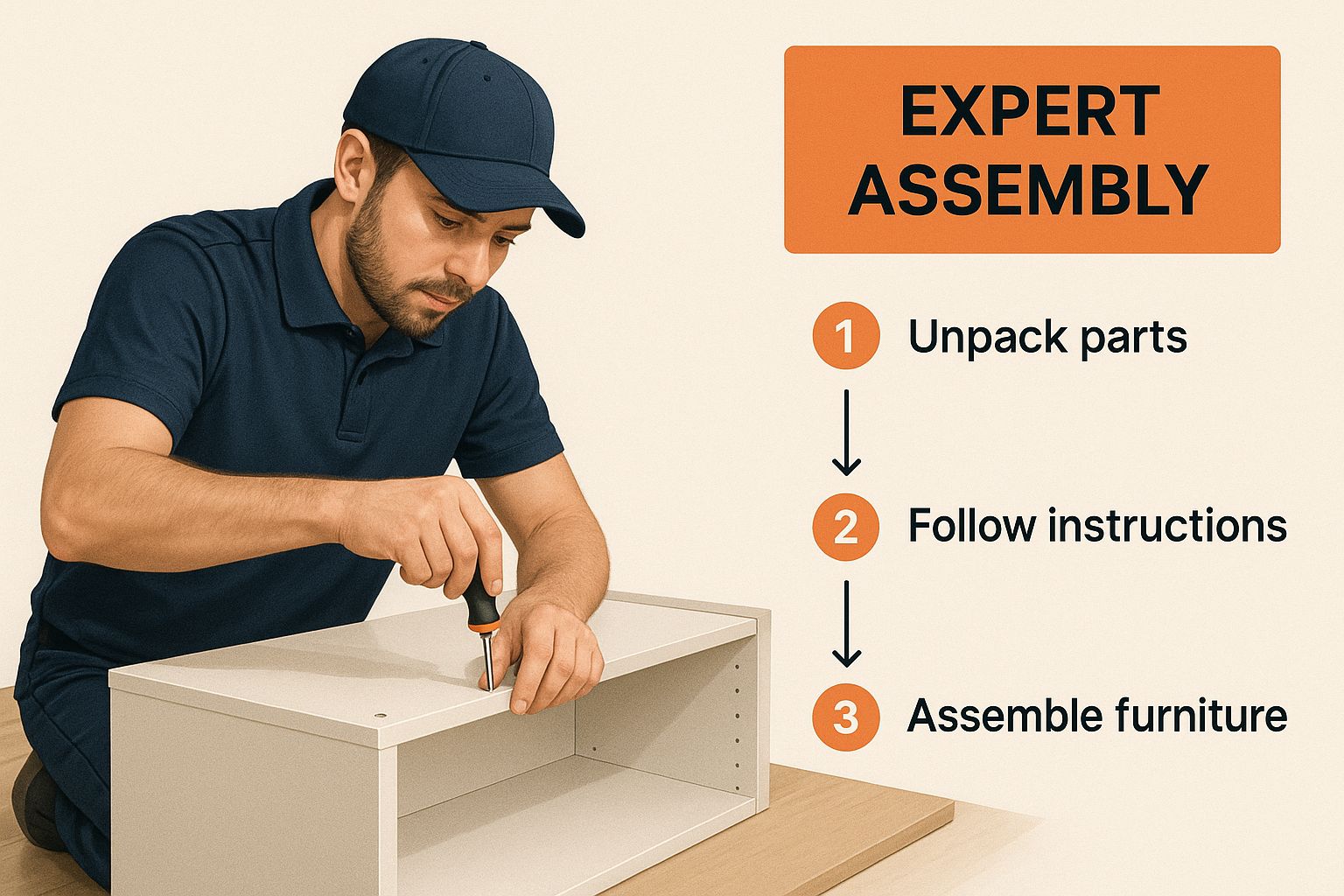-
CALL US:
- (866) 952-3456
Let's be real—that moment you're staring at a giant, flat box full of parts and a manual that looks like it's written in another language can be pretty defeating. Deciding to find the best furniture assembly service isn’t about giving up. It's about making a smart, practical choice to get a perfectly built piece of furniture without the headache. A pro ensures your new investment is solid and secure right from the start.
Skipping the DIY struggle is often the best call you can make. The convenience alone is a huge reason people are turning to professionals, especially with ready-to-assemble (RTA) furniture becoming more popular than ever. This trend is actually a big deal, fueling growth in the global furniture assembly market, which is projected to see a 6.0% annual growth, according to Archive Market Research.
Beyond convenience, you're protecting your purchase. A seasoned assembler just knows the quirks of different brands, whether it’s a massive IKEA PAX wardrobe or a tricky Wayfair media console. They come equipped with the right tools and, more importantly, the experience to sidestep common mistakes like stripped screws, wobbly legs, or doors that just won't line up. These little errors can ruin the look and even the structural integrity of your furniture.
The real cost of a DIY project isn't just the price tag on the box. It’s the risk of a bad build that could void a warranty or cause the piece to wear out way too soon. Think of a professional assembly as an investment in making your furniture last.
Professional assemblers are also lifesavers during a move. They have the know-how to properly disassemble your beloved furniture and, just as crucial, reassemble it correctly in your new space. This simple step ensures nothing gets damaged in transit. If you're figuring out what to do with pieces you're not taking, you can find some great tips for handling furniture during a move.
Ultimately, hiring a pro turns what could be a stressful, weekend-long project into a completely hands-off event. You get to enjoy your new furniture right away, minus the frustration. And if you're weighing the pros and cons for specific brands, our guide on why you should hire a professional for IKEA furniture might be just what you need.
Finding a great furniture assembly service isn't just about a quick online search. Let's be honest, anyone can build a slick website and call themselves a pro. The real trick is separating the seasoned experts from the amateurs who might turn your brand-new purchase into a wobbly mess.
You want to hire with confidence, knowing your investment is in good hands.
Instead of taking generic claims at face value, it’s time to ask the kind of practical questions that only a true professional can answer confidently. Don't just ask, "Do you have experience?" Ask, "Can you show me a picture of the exact same IKEA PAX wardrobe you built for another client?" This is especially critical for more complex or custom pieces.
When you're vetting potential assemblers, hard evidence is your best friend. A legitimate, trustworthy service will have zero hesitation about providing their credentials. It’s a huge red flag if they can't or won't.
Here’s what you should be asking for:
This is the level of professionalism and care you should expect. A quality service is about more than just brute force; it’s about having the right skills and tools for a perfect result.

A critical mistake is choosing a service based on price alone. An unusually low quote might signal a lack of insurance, experience, or accountability, putting your new furniture and your home at risk.
Taking the time to verify these details is what separates a smooth, stress-free assembly day from a frustrating and potentially expensive nightmare. It ensures you’re not just hiring someone with a toolbox, but a true professional who takes pride in their work.

Figuring out what a furniture assembly job should cost can feel like a total guessing game. But it doesn't have to be. When you start reaching out to pros, you’ll quickly find there are two main ways they charge: by the hour or a flat fee for the whole job. Understanding the difference is the key to not getting hit with a surprise on your bill.
So, when does each one make sense? A flat fee is usually your best bet for a single, complicated piece. Think of a big wardrobe with sliding doors or an entertainment center with a dozen different compartments. You know the exact price upfront, and it doesn't matter if it takes them a little longer than planned.
On the flip side, an hourly rate is often perfect when you've got a room full of relatively simple items. Maybe you bought two nightstands, a small bookshelf, and a coffee table. A good assembler can power through those efficiently, and you only end up paying for the actual time they spent working.
To get a firm, no-nonsense price, you need to be crystal clear about the job. Just saying "I need a dresser built" isn't enough. A true professional needs the details to give you an accurate price, and being transparent from the start makes the whole process smoother for everyone.
Here's what you need to provide to get a precise estimate:
The most reliable quotes come from being a little over-prepared. A pro will appreciate the extra information because it allows them to price the job fairly and block out the right amount of time, which prevents those dreaded "unexpected" charges on your final invoice.
A great price can turn sour fast if it’s hiding extra fees. Before you commit, you need to play detective and ask about the common charges that might not be included in the initial quote. For a really deep dive, our guide on furniture assembly cost breaks down everything you need to know.
Always ask if the price includes things like travel surcharges (if you're outside their main service area) or fees for hauling away the mountain of cardboard and packaging. Getting clarity on these points upfront is the best way to ensure the price you’re quoted is the price you actually pay.
A little prep work before your assembler arrives can make a world of difference. It's the key to turning a potentially chaotic day into a smooth, stress-free event and helps the pro work efficiently, which can save you money on hourly rates.
First things first, do a quick inventory check. Make sure all the boxes for your new furniture have actually arrived and get them into the room where the finished piece will live. There's nothing worse for everyone involved than getting halfway through a build only to realize box #3 of 4 is missing. This simple step avoids frustrating delays and potential rescheduling fees.
With the boxes accounted for, your next focus should be on creating a proper workspace. This is one of the most critical parts of a successful assembly day.
You’ll want to clear an area that is significantly larger than the footprint of the furniture itself. I can't stress this enough. Assemblers often need to build pieces on their side or back before standing them up, so having plenty of room to maneuver is non-negotiable.
Here’s a quick checklist to get the space ready for showtime:
From my experience, taking just 15 minutes to prepare the room before the appointment can easily save an hour of labor costs. It allows the professional to get straight to work instead of spending your billable time moving decor or clearing a space.
Getting this prep work right is becoming more important as demand for professional help grows. The global market for these services hit around $8.5 billion in 2023 and is only expected to climb.
For a more detailed checklist on what to do before your pro arrives, check out our complete guide on how to prepare for your furniture assembly project.

The job isn't quite over just because the tools are being packed up. Before you sign off on the work and your assembler heads out, it’s really important to do a quick final walkthrough. This little inspection is your best bet to make sure you’re happy with the job and, more importantly, that your new furniture is safe and ready to go.
Don't feel awkward about giving everything a good look-over; any true professional will expect you to. In fact, they should welcome it. After all, finding the best furniture assembly service means hiring someone who stands behind their work. This is your moment to spot any minor issues before they turn into major headaches later on.
Start with the basics. Open and close every drawer. Do they glide smoothly or do they catch? Check that all the cabinet doors hang evenly and close flush against the frame. Give the whole piece a gentle push from a couple of different angles—it should feel solid, with absolutely no wobbling or rocking.
Running through a quick, systematic check only takes a few minutes but gives you complete peace of mind. Give every surface, corner, and edge a scan for any new scratches or scuffs that might have happened during the assembly.
Here’s what your quick once-over should cover:
Taking a moment for this final review is non-negotiable. It's the last step in guaranteeing you received the quality service you paid for and that your furniture is built to last. It protects both you and the assembler.
Once you're satisfied with the build quality, there’s just one thing left: that mountain of cardboard and plastic. Many services will offer to haul away all the packaging for an extra fee, which can be a lifesaver. Otherwise, you can break down the boxes for your local recycling pickup.
Finally, if you were happy with the service, think about leaving a detailed and honest online review. It’s one of the best ways to thank a pro for a job well done and helps other people in your community find a reliable service for their own projects.
When you're bringing a professional into your home for the first time, it’s only natural to have a few questions. You’re not just booking an appointment; you're looking for someone you can trust to get the job done right. Here are some of the most common things people ask us, with straightforward answers from our experience.
Believe it or not, this happens more often than you'd think. The first thing a true professional will do is stop what they're doing. They'll pull out the instruction manual, pinpoint exactly which part is missing, and let you know immediately.
A good assembler should never try to jam in the wrong screw or skip a step entirely. That's a huge red flag because it compromises the safety and integrity of the furniture. Their job is to tell you what's wrong so you can contact the store or manufacturer for the correct replacement part.
Here's the bottom line: An assembler’s responsibility is to build the item exactly as the manual instructs. They can't control what the factory puts in the box, but they are absolutely responsible for identifying the problem and communicating it to you clearly.
Tipping is never mandatory, but it’s always appreciated for great service. If your assembler showed up on time, was professional, and expertly navigated a really tricky build, a tip is a fantastic way to show you’re happy with their work.
For a job well done, 15-20% of the service cost is a pretty standard amount. This is especially considerate for those tougher jobs, like carrying heavy boxes up several flights of stairs or tackling a monster wardrobe that took hours to complete.
The time it takes can swing wildly depending on the piece of furniture. A small, simple item is a world away from a complex one.
Just to give you a rough idea:
When you get your quote, always ask for a time estimate. An experienced pro can usually give you a pretty accurate ballpark figure based on the specific item. For more complicated projects or detailed questions, getting professional furniture assembly help upfront will set clear expectations and make the whole process go smoothly.
Ready to skip the frustration and get your furniture built right the first time? Assembly Smart offers transparent, upfront pricing and next-day appointments to get the job done quickly and professionally. Book your stress-free assembly online today!